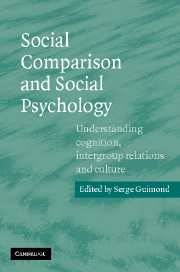Book contents
- Frontmatter
- Contents
- List of figures
- List of tables
- List of contributors
- Preface
- Introduction: social comparison processes and levels of analysis
- Part 1 Cognition: comparison processes within and between individuals
- Part 2 Intergroup relations: comparison processes within and between groups
- 5 Predicting comparison choices in intergroup settings: a new look
- 6 The variable impact of upward and downward social comparisons on self-esteem: when the level of analysis matters
- 7 Attitudes toward redistributive social policies: the effects of social comparisons and policy experience
- 8 Social comparison and group-based emotions
- 9 The counter-intuitive effect of relative gratification on intergroup attitudes: ecological validity, moderators and mediators
- 10 Social comparison and the personal group discrimination discrepancy
- Part 3 Culture: comparison processes within and across cultures
- Author index
- Subject index
- References
10 - Social comparison and the personal group discrimination discrepancy
Published online by Cambridge University Press: 27 October 2009
- Frontmatter
- Contents
- List of figures
- List of tables
- List of contributors
- Preface
- Introduction: social comparison processes and levels of analysis
- Part 1 Cognition: comparison processes within and between individuals
- Part 2 Intergroup relations: comparison processes within and between groups
- 5 Predicting comparison choices in intergroup settings: a new look
- 6 The variable impact of upward and downward social comparisons on self-esteem: when the level of analysis matters
- 7 Attitudes toward redistributive social policies: the effects of social comparisons and policy experience
- 8 Social comparison and group-based emotions
- 9 The counter-intuitive effect of relative gratification on intergroup attitudes: ecological validity, moderators and mediators
- 10 Social comparison and the personal group discrimination discrepancy
- Part 3 Culture: comparison processes within and across cultures
- Author index
- Subject index
- References
Summary
This chapter is about the correspondence between the psychology and social reality of devalued group membership. Well-being and the subjective satisfaction with life are, at best, modestly related to the objective conditions in which that life takes place. Often, members of minorities or otherwise devalued groups experience similar levels of self-esteem as members of objectively more privileged groups (for a review, see Crocker and Major, 1989). More surprisingly, they report very low levels of personal discrimination even if they are fully aware of the extent to which their group is discriminated against (Crosby, 1982). Thus, it would appear that they perceive themselves as less vulnerable to discrimination than the average member of their group. This discontinuity between judgments of discrimination for self and group has been called the personal-group discrimination discrepancy or PGDD (Crosby, 1982; Taylor, Wright, and Porter, 1994). It is a very robust effect that is found in a wide variety of devalued groups (Taylor, Wright, Moghaddam, and Lalonde, 1990).
The purpose of this chapter is to elaborate on prior work examining the role of social comparison processes in personal and group judgments of discrimination. Specifically, we consider the different goals and motivations involved in these perceptions and elaborate on the hypothesis that is being tested when personal versus group judgments of discrimination are made. One of the most significant consequences of social comparison activities is that they can alter feelings of entitlement, perceptions of being discriminated against, and the perceived relevance of various social categories.
- Type
- Chapter
- Information
- Social Comparison and Social PsychologyUnderstanding Cognition, Intergroup Relations, and Culture, pp. 228 - 246Publisher: Cambridge University PressPrint publication year: 2005
References
- 1
- Cited by

